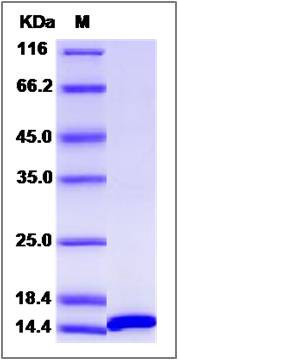Mouse FABP4 / ALBP / A-FABP / AFABP Protein (His Tag)
422/aP2,ALBP/Ap2,Ap2,Lbpl
- 100ug (NPP3311) Please inquiry
| Catalog Number | P50652-M07E |
|---|---|
| Organism Species | Mouse |
| Host | E. coli |
| Synonyms | 422/aP2,ALBP/Ap2,Ap2,Lbpl |
| Molecular Weight | The recombinant mouse FABP4 consists of 138 amino acids and predicts a molecular mass of 15.5 KDa. It migrates as an approximately 15 KDa band in SDS-PAGE under reducing conditions. |
| predicted N | Met |
| SDS-PAGE |  |
| Purity | > 95 % as determined by SDS-PAGE |
| Protein Construction | A DNA sequence encoding the mouse FABP4 (NP_077717.1) (Cys2-Ala132) was expressed with a polyhistidine tag at the N-terminus. |
| Bio-activity | |
| Research Area | Immunology |Signal Transduction |Metabolism |Lipid metabolism |
| Formulation | Lyophilized from sterile 50mM tris, 0.2 M NaCl, pH 7.5. 1. Normally 5 % - 8 % trehalose and mannitol are added as protectants before lyophilization. Specific concentrations are included in the hardcopy of COA. |
| Background | Mouse fatty acid-binding protein, adipocyte, also known as Adipocyte-type fatty acid-binding protein, Fatty acid-binding protein 4, Adipocyte lipid-binding protein, and FABP4, is a cytoplasm protein which belongs to the calycin superfamily and Fatty-acid binding protein (FABP) family. In familial combined hyperlipidemia (FCHL), FABP4 correlated to body mass index (BMI), waist circumference and homeostasis model assessment (HOMA) index.FABP4 levels were associated with triglyceride-rich lipoproteins. In humans serum FABP4 levels correlate significantly with features of PCOS. It appears to be a determinant of atherogenic dyslipidemia. FABP4 pathway mediates the sebaceous gland hyperplasia in keratinocyte-specific Pten-null mice. FABP4 concentration significantly increased with an increasing of MS features and was strongly correlated with body-mass index, triglycerides, HDL-cholesterol concentrations and blood pressure. Patients in the highest quartile of FABP4 presented a six-fold increased odds ratio for MS and a three-fold increased odds for LD, adjusted by age, sex, body-mass index and the antiretroviral therapy. FABP4 is a strong plasma marker of metabolic disturbances in HIV-infected patients, and therefore, could serve to guide therapeutic intervention in this group of patients. |
| Reference |
